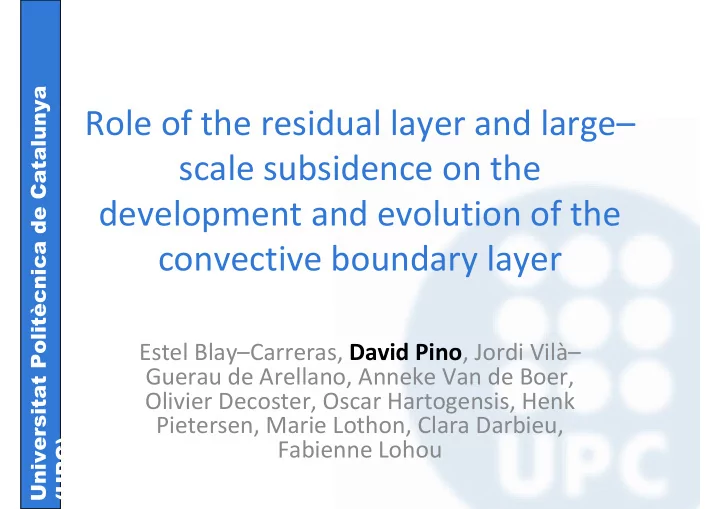

Universitat Politècnica de Catalunya Role of the residual layer and large– scale subsidence on the development and evolution of the convective boundary layer Estel Blay–Carreras, David Pino , Jordi Vilà– Guerau de Arellano, Anneke Van de Boer, Olivier Decoster, Oscar Hartogensis, Henk Pietersen, Marie Lothon, Clara Darbieu, (UPC) Fabienne Lohou
Motivation Universitat Politècnica de Catalunya • Which role play RL during the morning transition? • How important is subsidence during the whole evolution of the convective boundary layer? • How potential temperature, boundary–layer depth and TKE budget evolve depending on the presence of RL? • What are the consequences to the observed (UPC) CO 2 mixing ratio?
Methodologies Universitat Politècnica de Catalunya • Observations taken during the BLLAST campaign (1 st July, IOP9). Eddy Covariance instruments at SS1 and radioundings. • Large-Eddy Simulations (DALES, Heus et al., 2011 ). Sensitivity studies varying the initial profile and subsidence. • Mixed-layer model. Subsidence is taken into account. (UPC)
Numerical experiments DALES (Heus et al., 2011) Universitat Politècnica de Catalunya 256 3 points. 12.8x12.8x3 km 3 domain From 0730 until 2000 UTC. MLM from 1100 UTC (developped CBL). Includes subsidence Surface Flux mean of EC observations at SS1 (UPC)
Numerical experiments Universitat Politècnica de Catalunya DALES (RL) initial profile based on radiosoundaing at 0730 UTC. Same FA lapse rate Subsidence calculated by comparing 0130 and 0730 UTC soundings (215 m in 6 h) Subsidence velocity � 9.95 · (UPC) 10 −3 m s −1
Numerical experiments Initial wind profile (based on RS at 0730 UTC) Universitat Politècnica de Catalunya • below the FA � u = −2.95, v = 0.52 m s −1 • At FA similar to geostrophic wind Geostrophic wind: u g = 10, v g = 0 m s −1 � constant with height 0730 UTC 1100 UTC Four different DALES runs are performed by combining residual layer & subsidence (UPC)
Results Universitat Politècnica de Catalunya Temporal evolution of: • Potential temperature vertical profile • 2-m potential temperature • Boundary layer depth (first inversion from the surface) • Turbulent kinetic energy vertical profile (UPC) • Observations CO 2 mixing ratio & surface flux
Potential temperature vertical profile Universitat Politècnica de Catalunya 0830 UTC RLs case (solid blue) fit the potential temperature (UPC) 1100 UTC measured by RS
Potential temperature vertical profile Universitat Politècnica de Catalunya RLs case (solid 1400 UTC blue) fit the potential temperature measured by RS (UPC) 1700 UTC
Mixed–layer potential temperature Universitat Politècnica de Catalunya Larger heat fluxes observed over wheat (Nadeau et al., 2011) 2 1 Two regims observed (symbols): (UPC) 1. Low BL, large inversion. Large heating rate. 2. Large BL, smaller inversion. Smaller heating rate.
Mixed–layer potential temperature Universitat Politècnica de Catalunya Same surface heat flux for all numerical experiments (lines). RL (blue) cases fit observations. Two regimes are simulated. (UPC) nRL (green) overestimates the observed 2-m temperature.
Boundary–layer depth temporal evolution Universitat Politècnica de Catalunya Minimum buoyancy flux Maximum virtual potential temperature gradient RL cases simulate the inclusion of RL into BL nRL cases � 4 hours delay Subsidence play an important role � no subsidence cases overestimate the depth (UPC) 200 m
Entraiment heat flux Universitat Politècnica de Catalunya Before the transition larger entrainment fluxes for the nRL case (strong inversion). At the transition, the minimum of the heat flux increases due to (UPC) the increase of ∆θ 1 and entrainment velocity. Afterwards, RL and nRL cases present similar entrainment flux.
Turbulent kinetic energy budget Universitat Politècnica de Catalunya 0830 UTC 0900 UTC Increase of Larger Shear and Buoyancy RL terms RL Buoyancy terms for nRL during the early morning (Beare, 2008) Turbulence 0900 UTC 0830UT C decreases when Decrease BL grows and Shear and nRL nRL Buoyancy inversion terms weakens (UPC)
Conclusions Universitat Politècnica de Catalunya • DALES RL cases fit the observations. • During the inclusion of RL, entrainment heat flux increases. Afterwards, similar entrainment heta flux is obtained for all the cases. • Subsidence is important to correctly simulat the BL- evolution during the afternoon. • Shear and buoyancy terms are the largest during morning . After the inclusion of the RL, buoyancy increases in the lower part of the CBL and at the inversion and shear decreases at the inversion. (UPC)
CO 2 surface flux and mixing ratio Universitat Politècnica de Catalunya 0600 – 0900 UTC � important decrease of the CO 2 mixing ratio due to entrainment. Transition cannot be observed in the CO 2 mixing ratio For all the land uses, C is approx constant (less than 1 ppm variation) from midday. (UPC)
Universitat Politècnica de Catalunya (UPC) CO 2 surface flux and mixing ratio entrainment Decrease due to CO 2 surface fluxes Clear differences in the
Conclusions Universitat Politècnica de Catalunya • During the morning, CO 2 mixing ratio decreases even with positive CO 2 fluxes due to the importance of CO 2 entrainment flux. • During the afternoon, CO 2 mixing ratio is almost constant and small differences are found depending on the landuse (storage term is very small) due to the large value of z 1 . (UPC)
Recommend
More recommend